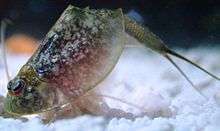Triops newberryi
Triops newberryi is a species of Triops found on the western coast of North America, commonly in valleys throughout the states of Washington, Oregon, California, and small areas of Nevada, Utah, New Mexico, and Mexico, with at least one disjunct population in Kansas.[1] They are found in vast numbers though in the Coachella Valley in California.[2] T. newberryi has been reported to have potential as a biocontrol agent for larval mosquitoes breeding in seasonally-flooded habitats.[2] T. newberryi is genetically distinct from T. longicaudatus, the dominant species in the Central United States.[1]
| Triops newberryi | |
|---|---|
 | |
| Scientific classification | |
| Kingdom: | |
| Phylum: | |
| Subphylum: | |
| Class: | |
| Order: | |
| Family: | |
| Genus: | |
| Species: | T. newberryi |
| Binomial name | |
| Triops newberryi Thomas, 1921 | |
| The range of Triops newberryi | |
In Captivity
Though Triops newberryi is the species most likely to be encountered in the wild on the west coast of North America, it is far less common than Triops cancriformis and Triops longicaudatus in captivity, and is considered a more 'exotic' species among hobbyists.
References
- Sassaman, C.; Simovich, M.A.; Fugate, M. (1997). "Reproductive isolation and genetic differentiation in North American species of Triops (Crustacea: Branchiopoda: Notostraca)". Hydrobiologia. 359 (1–3): 125–147. doi:10.1007/978-94-017-3177-5_14. ISBN 978-90-481-5001-4.
- Su, Tianyun; Mulla, Mir S. (2002). "Spatial occurrence and hatch of field eggs of the tadpole shrimp Triops newberryi (Notostraca: Triopsidae), a potential biological control agent of immature mosquitoes" (PDF). Journal of Vector Ecology. 27 (1): 138–148. PMID 12125865.